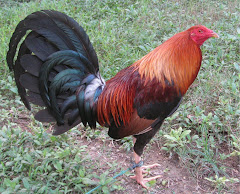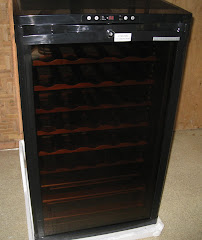Sunday, May 3, 2009
The good fuel
The Good Fuel
In human beings, the difference between an elite athlete and ordinary persons are the pumping strength of the heart, the ability of the respiratory system to take in adequate oxygen and blow off carbon dioxide, and the amount of fuel that can be stored in the liver. (Guide to Energy Boosting Supplement; Donald Hunningshake, M.D.) This could be the case in gamefowl too. And these things can be developed, improved and maintained through proper training and right nutrition.
To understand how scientific nutrition could help it is necessary to learn how metabolism converts energy in food to energy in the body. The different nutrients: protein, fats, carbohydrates, vitamins and minerals play major parts in the process.
When we eat, food is broken down into its simplest components. Protein is broken down into amino acids. Fat into fatty acids, Carbohydrates into glucose. These substances pass through the intestine to the larger blood vessels, to the thin cappiliaries. Then they move through each of the cells in the body. Amino acids build and repair cells. Fatty acids can be used as fuel later, through the process called beta-oxidation. Glucose becomes the ready source of energy.
There are three steps in the process of converting food to energy. Glycolysis, the Krebs cycle, and the electron transport chain. No need to be very technical here. The bottom line is that efficiency of the entire process depends not only on the machine, which is the body, but also on the quality of the fuel, the food. This is where good nutrition comes in.
Initial Burst: The ATP-CP energy
There are two kinds of energy conversion. The anaerobic or without the use of oxygen and the aerobic or with the help of oxygen. Again, we will avoid becoming too technical and limit our discussion of the matter to a practical viewpoint from where we could relate it to gamefowl conditioning.
In the first burst of activity, the muscles rely on the ATP-CP (Adenosine Triphosphate – Creatine Phosphate) energy pathway which is anaerobic. After a few seconds, the muscles draw energy from glycolysis, which is common to anaerobic and aerobic pathways. The end product of glycolysis, pyruvate, represents a fork in the catabolic (breaking down) process. Pyruvate could be committed to the anaerobic pathway or to the mitochondria leading to the Krebs cycle and the electron transport chain, both of which are aerobic in nature.
When the contest drags on, the body will have to rely for energy on these two aerobic pathways. Cockfighting, however, is more of a sprint than a marathon. Focus should be on anaerobic energy pathway.
Quick Energy: Creatine Ribose
When the muscle contracts, the initial fuel it utilizes is adenosine triphosphate, or ATP.
“ATP releases one of its phosphate molecules to provide energy for muscle contraction and other functions. Once ATP releases a phosphate molecule, it becomes a different compound called ADP (Adenosine Diphosphate). Unfortunately, there is only enough ATP to provide energy for about 10 seconds, so for this energy system to continue ATP must be produced.
Creatine Phosphate (CP) comes to the rescue by giving up its phosphate molecule to ADP, recreating ATP. This ATP can then be burned again as fuel for more muscle contraction. The bottom line is that your ability to regenerate ATP largely depends on your supply of creatine. The more creatine you have in your muscles, the more ATP you can remake.” (Dave Tuttle; User’s Guide to Sports Nutrients)
Otherwise the body will be forced to rely on another energy pathway, glycolysis. The pathway has a by-product that irritates the muscles, causes pain, and interferes with biochemical reactions necessary for muscles to do the job, thus fatigue sets in. So, the earlier the body relies on glycolysis for energy, the earlier it gets tired.
The other pathways –the Krebs cycle and the electron transport chain – are aerobic or employ oxygen. Aerobic convention takes over when the activity is prolonged but less intense or less than maximal effort. This seldom happens in cockfights.
Most important in cockfights is the initial bursts of energy. We have learned that the body can achieve maximum amount of energy if the muscles have enough supply of ATP. And, creatine is what enables the resynthesis of ATP to take place. But during heavy exertion of effort as what transpires in the first few buckles of a cockfight, creatine cannot resynthesize ATP fast enough. Fortunately, ribose can help speed up the process.
Welcome. To read the articles, please click post link or month, then subsequent post link.
Ponkan broodcock

One of the ponkan broodcocks being readied by RB Sugbo for the incoming breeding season. RB Sugbo is among the gamefowl farms very much involved in the Masang Nagmamanok (MANA) Inc. nationwide gamefowl dispersal program.
Another ponkan

Another ponkan broodcock in the trio pen.
Mana: Dami at Pagkakaisa
Walang duda napakalaki na ng pinagunlad ng sabong mula sa paging libangan tuwing araw ng Linggo, ito ngayon ay isa nang napakatanyag na isport, malaking industriya at kaakitakit na mapagkakitaan.
Napakarami nang nagpapalahi ng manok panabong. Nagsilabasan ang mga babasahin at programa sa telebisyon ukol sa sabong.
Sa bawat nagpapalahi, ilan ang tagapagalaga ng kanyang manok? Sa bawat may-ari ng sabungan, ilan ang naghahanapbuhay sa sabungan niya? Sa bawat kasali sa derby, ilan ang nagbabayad sa pinto upang manood? Sa bawat malaking sabungero, ilan ang mayroon lang iilang pirasong tinale sa kanilang bakuran? Dapat lang, at napapanahon na siguro, na ang masang sabungero ay mapagtuonan ng pansin, mabigyan ng kinatawan, at, marinig ang boses sa isport at industriya ng sabong.
Ito ang nais abutin ng MANA (Masang Nagmamanok), isang pambansang kilusan at samahan ng mga masang sabungero. Ang mga layunin ng MANA ay ang sumusunod:
1. Ang pangalagaan ang kapakanan ng mga maliit na sabungero, partikular na, ang mga naghahanapbuhay sa sabungan. Inaasam na sa darating na panahon, ang mga handlers, mananari, casador, kristos, sentensiyador, farm hands ay magkakaroon ng mga benepisyo tulad ng insurance, pension at iba pa.
2. Ang mapatingkad ang kaalaman ng ordinaryong sabungero sa pagmamanok. At, sila’y mabigyan ng pagkakataon na magkaroon ng angkop na materyales sa pagpapalahi at paglalaban.
3. Ang ipaglaban ang sabong sa gitna ng banta na itoy gawing labag sa batas tulad ng nangyari kamakailan lang sa Estados Unidos, at ipreserba ito bilang isport, hanapbuhay, industriya at bahagi ng ating kultura at tunay na mana.
4. Ang magtulungan at makipagtulungan sa iba pang haligi ng industriya sa ikabubuti ng sabong at ikauunlad ng lahat na mga sabungero.
Inaasahan na matupad ng MANA ang nasabing mga layunin pamamagitan ng pagpakita ng dami at pagkakaisa.
Ang pagkatatag ng MANA ay bunsod ng mungkahi ni kamanang Boying
Ang Llamado Tayo ay tumatalakay sa ibatibang aspeto sa pagmamanok at binabasa ng napakarami arawaraw, kaya di nagtagal marami ang sumapi sa MANA.
Kasunod nito, ang MANA ay nakapagpaseminar sa ibatibang lugar at rehiyon ng Pilipinas, sa tulong ng mga kumpaniya tulad ng Excellence Poultry & Livestock Specialist, Bmeg-Derby Ace, Sagupaan, Secret Weapon, at Thunderbird.






